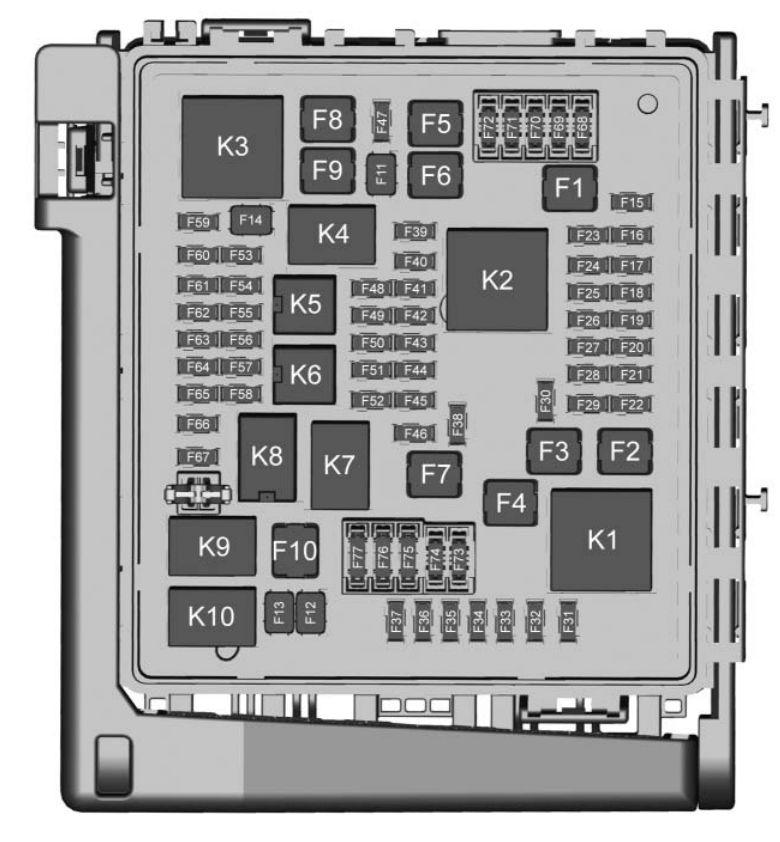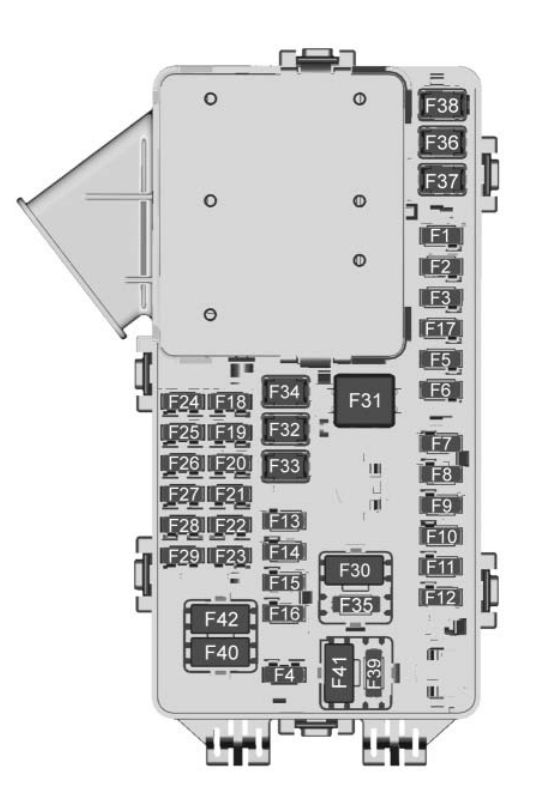Chevrolet Traverse (2018) fuse box and relay Diagrams

The 2018 Chevrolet Traverse is a midsize SUV that stands out for its spacious interior, advanced technology, and improved performance. As a vehicle designed to cater to families and those needing ample cargo space, the Traverse’s electrical system plays a vital role in powering its wide array of features, with the fuse box and relays being essential components that ensure its efficient operation.
The fuse box in the 2018 Chevrolet Traverse is integral to protecting the vehicle’s various electrical circuits. These circuits power critical systems such as engine management, lighting, infotainment, climate control, and power accessories like windows, seats, and the liftgate. Typically, the Traverse features two main fuse boxes: one in the engine compartment and another inside the cabin, often located beneath the dashboard or in the passenger side footwell. The engine compartment fuse box oversees high-power systems associated with the engine and transmission, while the interior fuse box handles comfort and convenience features.
Each fuse is dedicated to a specific circuit and is designed to “blow” in the event of an overload or short circuit, cutting off the power supply to prevent damage to the circuit or the vehicle’s components. This feature is crucial for preventing electrical fires and avoiding costly repairs. For instance, if systems like the power seats or exterior lights stop working, inspecting the related fuse should be the first step in diagnosis.
Relays are electrically operated switches that control the power supply to high-current systems, such as the starter motor, fuel pump, and cooling fans. Relays enable these high-demand systems to be operated by lower-power circuits, ensuring that the vehicle’s wiring and switches are not overloaded and function safely and efficiently.
Regular inspection and maintenance of the fuse box and relays in the Chevrolet Traverse are essential to avoid electrical issues. If a fuse blows or a relay fails, it can result in system malfunctions, such as preventing the engine from starting if the starter relay is defective, or causing temperature regulation issues if the cooling fan relay is compromised. Replacing these components with the correct specification is vital to restoring functionality.
By understanding the importance of the fuse box and relays, Traverse owners can better maintain the SUV’s electrical system, ensuring that all features operate reliably and safely. This attention to maintenance helps provide a seamless and comfortable driving experience, reflecting the 2018 Traverse’s reputation as a versatile and family-friendly vehicle.
MUST READ: DYI – How to Check Car Fuses?
(2018) Chevrolet Traverse fuse box and relay with Diagram
WARNING
- Never replace a fuse with one that has a higher amperage rating.
- A fuse with a too-high amperage could damage the electrical part and cause a fire.
- On no account should fuses be repaired (e.g. patched up with tin foil or wire) as this may cause serious damage elsewhere in the electrical circuit or cause a fire.
- If a fuse blows repeatedly, do not keep replacing it. Instead, have the cause for the repeated short circuit or overload tracked and fixed.
- Terminal and harness assignments for individual connectors will vary depending on vehicle equipment level, model, and market.
Chevrolet Traverse 2018 fuse assignment
- Cigar lighter (power outlet) fuses in the Chevrolet Traverse are located in the Engine Compartment Fuse Box (see fuses “AUX POWER” (Auxiliary Power), “CIGAR LIGHTER” (Cigar Lighter), “PWR OUTLET” (Power Outlet) and “RR APO” (Rear Accessory Power Outlet)).
Year of production: from 2018
Engine Compartment Fuse Block
The underhood fuse block is in the engine compartment, on the driver side of the vehicle.

| Fuses | Description |
| F1 | Antilock brake system pump |
| F2 | Starter 1 |
| F3 | DC DC transformer 1 |
| F4 | — |
| F5 | DC DC transformer 2 |
| F6 | — |
| F7 | — |
| F8 | — |
| F9 | Vacuum pump |
| F10 | Front wiper |
| F11 | — |
| F12 | — |
| F13 | Starter 2 |
| F14 | — |
| F15 | Rear wiper |
| F16 | — |
| F17 | — |
| F18 | — |
| F19 | — |
| F20 | — |
| F21 | — |
| F22 | Electronic brake control module |
| F23 | Parking/Trailer lamps |
| F24 | Right trailer stoplamp/Turnlamp |
| F25 | Steering column lock |
| F26 | — |
| F27 | Left trailer stoplamp/Turnlamp |
| F28 | — |
| F29 | — |
| F30 | Washer pump |
| F31 | — |
| F32 | Left low – beam headlamp |
| F33 | Front fog lamps |
| F34 | Horn |
| F35 | — |
| F36 | — |
| F37 | Right low – beam headlamp |
| F38 | Automatic headlamp leveling motor (if equipped) |
| F39 | Transmission control module |
| F40 | Left rear bus electrical center/Ignition |
| F41 | Instrument cluster |
| F42 | Heating, ventilation, and air conditioning |
| F43 | Head-up display (if equipped) |
| F44 | Communication gateway module/Run/Crank (if equipped) |
| F45 | — |
| F46 | — |
| F47 | — |
| F48 | — |
| F49 | Interior rearview mirror |
| F50 | Fuel system control module |
| F51 | Heated steering wheel |
| F52 | Folding seats switch |
| F53 | — |
| F54 | Coolant pump |
| F55 | Air conditioning clutch |
| F56 | Integrated chassis control module |
| F57 | Engine control module/Ignition |
| F58 | Transmission control module/Ignition |
| F59 | Engine control module battery |
| F60 | — |
| F61 | O2 sensor 1/MAF/Aeroshutter |
| F62 | Engine control module – even 1 |
| F63 | O2 sensor 2/Canister/Engine oil/Turbo |
| F64 | Engine control module – even 2 |
| F65 | Engine control module powertrain 1 |
| F66 | Engine control module powertrain 2 |
| F67 | Engine control module – odd |
| F68 | — |
| F69 | — |
| F70 | — |
| F71 | — |
| F72 | — |
| F73 | — |
| F74 | — |
| F75 | — |
| F76 | — |
| F77 | — |
| Relays | Usage |
| K1 | Starter 1 |
| K2 | Run/Crank |
| K3 | Vacuum pump |
| K4 | — |
| K5 | Air conditioning |
| K6 | Coolant pump |
| K7 | Engine control module |
| K8 | Folding seats |
| K9 | — |
| K10 | Starter 2 |
Instrument Panel Fuse Block
The instrument panel fuse block is located under the instrument panel on the passenger side of the vehicle.

| Fuses | Description |
| F1 | Body control module 6 |
| F2 | Diagnostic link |
| F3 | Electric steering column lock |
| F4 | Rear USB |
| F5 | — |
| F6 | Heating, ventilation, and air conditioning |
| F7 | Body control module 3 |
| F8 | — |
| F9 | Right front heated seat |
| F10 | Airbag |
| F11 | Electronic precision shift |
| F12 | Amplifier |
| F13 | Body control module 7 |
| F14 | Left front heated seat |
| F15 | — |
| F16 | Sunroof |
| F17 | Communication gateway module (if equipped) |
| F18 | Instrument cluster |
| F19 | Body control module 1 |
| F20 | Wireless charger module |
| F21 | Body control module 4 |
| F22 | Infotainment |
| F23 | Body control module 2 |
| F24 | — |
| F25 | Parking assist |
| F26 | Communications integration module |
| F27 | Video |
| F28 | Radio/Heating, ventilation, and air conditioning display |
| F29 | Radio |
| F30 | Steering wheel controls |
| F31 | Front blower |
| F32 | DC AC inverter |
| F33 | Driver power seat |
| F34 | Passenger power seat |
| F35 | Feed/Body control module 4 |
| F36 | Electric power steering |
| F37 | Power outlet/ Wireless charger/Accessory |
| F38 | Body control module 8 |
| F39 | Steering wheel controls backlighting |
| Circuit Breaker | Description |
| F40 | — |
| F41 | — |
| F42 | Auxiliary power outlet/Lighter |
Rear Compartment Fuse Block
The rear compartment fuse block is behind a trim panel on the driver side of the rear storage compartment.

| Fuses | Description |
| F1 | — |
| F2 | Trailer |
| F3 | Folding seats |
| F4 | Rear blower |
| F5 | Rear drive control |
| F6 | — |
| F7 | Right window |
| F8 | Rear defogger |
| F9 | Left window |
| F10 | — |
| F11 | Trailer reverse |
| F12 | USB/Third row seats |
| F13 | — |
| F14 | — |
| F15 | — |
| F16 | — |
| F17 | Camera |
| F18 | — |
| F19 | Ventilated seats |
| F20 | — |
| F21 | — |
| F22 | — |
| F23 | — |
| F24 | Lumbar |
| F25 | — |
| F26 | Trailer brake lamps |
| F27 | — |
| F28 | Passive entry/Passive start |
| F29 | — |
| F30 | Canister vent |
| F31 | — |
| F32 | Heated mirrors |
| F33 | USB/Second row seats |
| F34 | Liftgate module |
| F35 | Fuel system control module |
| F36 | — |
| F37 | — |
| F38 | Window module |
| F39 | Rear closure |
| F40 | Memory seat module |
| F41 | Automatic occupancy sensor |
| F42 | — |
| F43 | — |
| F44 | — |
| F45 | Liftgate motor |
| F46 | Rear heated seats |
| F47 | — |
| F48 | — |
| F49 | — |
| F50 | — |
| F51 | — |
| F52 | Semi-active dampening system module |
| F53 | — |
| F54 | External object calculating remote system/Blind zone alert |
| F55 | — |
| F56 | Universal garage door opener/Overhead console |
| F57 | Hands free closure release |
| Circuit Breaker | Description |
| CB! | — |
| CB2 | — |
| CB3 | Rear auxiliary power outlet |
| Relay | Description |
| K1 | — |
| K2 | — |
Conclusion
For owners and enthusiasts of classic Chevrolet Traverse 2018, understanding the fuse box and relay systems is essential for vehicle maintenance. Regular inspection and maintenance of these components helped ensure the vehicle’s longevity and reliability, preserving its status as a symbol of Chevrolet’s craftsmanship and innovation in the automotive industry during that era.